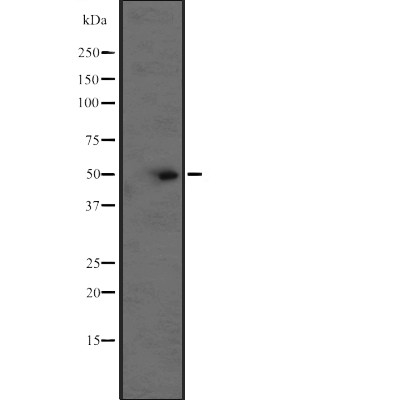BCL2L13 Antibody - #DF2649
| Product: | BCL2L13 Antibody |
| Catalog: | DF2649 |
| Description: | Rabbit polyclonal antibody to BCL2L13 |
| Application: | WB IHC |
| Reactivity: | Human |
| Prediction: | Pig, Bovine, Horse, Sheep, Rabbit, Dog, Chicken |
| Mol.Wt.: | 50 kDa.; 53kD(Calculated). |
| Uniprot: | Q9BXK5 |
| RRID: | AB_2839855 |
Product Info
*The optimal dilutions should be determined by the end user.
*Tips:
WB: For western blot detection of denatured protein samples. IHC: For immunohistochemical detection of paraffin sections (IHC-p) or frozen sections (IHC-f) of tissue samples. IF/ICC: For immunofluorescence detection of cell samples. ELISA(peptide): For ELISA detection of antigenic peptide.
Cite Format: Affinity Biosciences Cat# DF2649, RRID:AB_2839855.
Fold/Unfold
Apoptosis facilitator; B2L13_HUMAN; Bcl 2 like 13; Bcl 2 like 13 protein; Bcl-2-like protein 13; Bcl-rambo; BCL2 like 13 apoptosis facilitator; BCL2 like 13; Bcl2 like 13 protein; Bcl2-L-13; BCL2L13; MIL 1; MIL1; MIL1 protein; Protein Mil1;
Immunogens
A synthesized peptide derived from human BCL2L13, corresponding to a region within the internal amino acids.
Ubiquitous, with the highest levels of expression in heart, placenta and pancreas.
- Q9BXK5 B2L13_HUMAN:
- Protein BLAST With
- NCBI/
- ExPASy/
- Uniprot
MASSSTVPLGFHYETKYVVLSYLGLLSQEKLQEQHLSSPQGVQLDIASQSLDQEILLKVKTEIEEELKSLDKEISEAFTSTGFDRHTSPVFSPANPESSMEDCLAHLGEKVSQELKEPLHKALQMLLSQPVTYQAFRECTLETTVHASGWNKILVPLVLLRQMLLELTRRGQEPLSALLQFGVTYLEDYSAEYIIQQGGWGTVFSLESEEEEYPGITAEDSNDIYILPSDNSGQVSPPESPTVTTSWQSESLPVSLSASQSWHTESLPVSLGPESWQQIAMDPEEVKSLDSNGAGEKSENNSSNSDIVHVEKEEVPEGMEEAAVASVVLPARELQEALPEAPAPLLPHITATSLLGTREPDTEVITVEKSSPATSLFVELDEEEVKAATTEPTEVEEVVPALEPTETLLSEKEINAREESLVEELSPASEKKPVPPSEGKSRLSPAGEMKPMPLSEGKSILLFGGAAAVAILAVAIGVALALRKK
Predictions
Score>80(red) has high confidence and is suggested to be used for WB detection. *The prediction model is mainly based on the alignment of immunogen sequences, the results are for reference only, not as the basis of quality assurance.
High(score>80) Medium(80>score>50) Low(score<50) No confidence
Research Backgrounds
May promote the activation of caspase-3 and apoptosis.
Mitochondrion membrane>Single-pass membrane protein. Nucleus.
Nucleus.
Ubiquitous, with the highest levels of expression in heart, placenta and pancreas.
Belongs to the Bcl-2 family.
Research Fields
· Human Diseases > Infectious diseases: Bacterial > Legionellosis.
Restrictive clause
Affinity Biosciences tests all products strictly. Citations are provided as a resource for additional applications that have not been validated by Affinity Biosciences. Please choose the appropriate format for each application and consult Materials and Methods sections for additional details about the use of any product in these publications.
For Research Use Only.
Not for use in diagnostic or therapeutic procedures. Not for resale. Not for distribution without written consent. Affinity Biosciences will not be held responsible for patent infringement or other violations that may occur with the use of our products. Affinity Biosciences, Affinity Biosciences Logo and all other trademarks are the property of Affinity Biosciences LTD.
